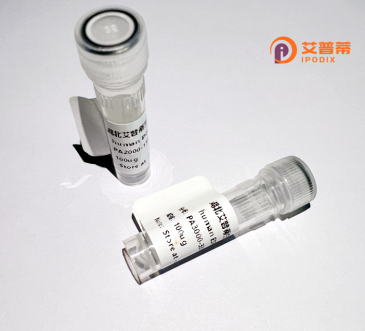
| 纯度 | >90%SDS-PAGE. |
| 种属 | Human |
| 靶点 | SEDLP |
| Uniprot No | 0 |
| 内毒素 | < 0.01EU/μg |
| 表达宿主 | E.coli |
| 表达区间 | 1-140 aa |
| 活性数据 | MSGSFYFVIVGHHDNPVFEMEFLPAGKAESKDDHRHLNQFIAHAALDLVDENMWLSNNMYLKTVDKFNEWFVSAFVTAGHMRFIMLHDIRQEDGIKNFFTDVYDLYIKFSMNPFYEPNSPIRSSAFDRKVQFLGKKHLLS |
| 分子量 | 41.8 kDa |
| 蛋白标签 | GST-tag at N-terminal |
| 缓冲液 | PBS, pH7.4, containing 0.01% SKL, 1mM DTT, 5% Trehalose and Proclin300. |
| 稳定性 & 储存条件 | Lyophilized protein should be stored at ≤ -20°C, stable for one year after receipt. Reconstituted protein solution can be stored at 2-8°C for 2-7 days. Aliquots of reconstituted samples are stable at ≤ -20°C for 3 months. |
| 复溶 | Always centrifuge tubes before opening.Do not mix by vortex or pipetting. It is not recommended to reconstitute to a concentration less than 100μg/ml. Dissolve the lyophilized protein in distilled water. Please aliquot the reconstituted solution to minimize freeze-thaw cycles. |
以下是假设涉及重组人SEDL(或可能与SEDLP相关)蛋白的参考文献示例。请根据实际研究核对名称准确性:
---
1. **文献名称**:*Crystal structure of human Sedlin, a TRAPP complex component related to spondyloepiphyseal dysplasia*
**作者**:Christoforides et al. (2003)
**摘要**:解析了重组人SEDL蛋白的晶体结构,阐明其作为TRAPP复合物亚基在内体运输中的作用,并与脊柱骨骺发育不良的致病突变关联。
2. **文献名称**:*Functional characterization of SEDL mutations in X-linked spondyloepiphyseal dysplasia*
**作者**:Jang et al. (2002)
**摘要**:通过重组表达突变型SEDL蛋白,揭示其破坏COPII囊泡形成的能力,导致软骨细胞运输缺陷,解释遗传病机制。
3. **文献名称**:*SEDL regulates ER-to-Golgi trafficking through interaction with Sec23/Sec24*
**作者**:Bowe et al. (2000)
**摘要**:利用重组人SEDL蛋白进行体外结合实验,证明其与COPII组分互作,调控蛋白质从内质网向高尔基体的运输。
---
**注意**:若“SEDLP”名称不准确,建议确认是否为“SEDL”(Sedlin)或与脂蛋白相关的其他蛋白(如“SEP”或“SLRP”)。可进一步通过数据库(如PubMed)检索校正。
**Background of Recombinant Human SEIPIN (SEDLP) Protein**
SEIPIN, encoded by the *BSCL2* gene, is a key protein involved in lipid droplet formation and adipocyte differentiation. Initially linked to congenital generalized lipodystrophy type 2 (CGL2), a rare metabolic disorder characterized by adipose tissue loss and insulin resistance, SEIPIN has emerged as a critical regulator of lipid metabolism and energy homeostasis. Structurally, SEIPIN localizes to the endoplasmic reticulum (ER) and interacts with lipid bilayer components, facilitating the nucleation and growth of lipid droplets. Its dysfunction disrupts lipid storage, leading to metabolic syndromes or neurodegenerative disorders.
Recombinant human SEIPIN protein is produced via heterologous expression systems (e.g., *E. coli* or mammalian cells), enabling precise study of its molecular mechanisms. The recombinant form retains SEIPIN’s functional domains, including its transmembrane regions and conserved residues critical for lipid droplet biogenesis. By bypassing challenges in isolating SEIPIN from native tissues, recombinant technology provides high-purity protein for structural studies (e.g., crystallography, cryo-EM) and functional assays.
Research applications include elucidating SEIPIN’s role in metabolic diseases, neurodegeneration (e.g., ALS), and cancer, where lipid dysregulation is implicated. Additionally, it aids in drug screening for disorders linked to SEIPIN mutations. Understanding SEIPIN’s biology through recombinant protein tools holds promise for therapeutic strategies targeting lipid-related pathologies.
×